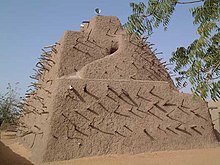Landmarks in Mali
This article may incorporate text from a large language model. (September 2024) |
Mali, located in West Africa, is a country rich in history, culture, and architectural heritage. From ancient mosques to stunning natural landscapes, Mali boasts a diverse array of landmarks that showcase its significance in the region and the world.
Timbuktu
[edit]Timbuktu, often referred to as the "City of 333 Saints,"[1] is a historic city located in northern Mali. It was once a major center of Islamic scholarship and trade during the Mali Empire and the Songhai Empire.[2] Timbuktu is renowned for its historic mosques, ancient manuscripts, and vibrant cultural heritage.

One of the most iconic landmarks in Timbuktu is the Great Mosque of Djenné, a UNESCO World Heritage Site.[3] Built in the 13th century, this mud-brick mosque is the largest of its kind in the world and is considered a masterpiece of Sudano-Sahelian architecture. The Great Mosque became one of the most important buildings in town primarily because it became a political symbol for local residents and for colonial powers like the French, who took control of Mali in 1892. The Great Mosque that we see today is its third reconstruction, completed in 1907.[4]
Bandiagara Escarpment
[edit]
The Bandiagara Escarpment is a sandstone cliff located in the Dogon Country of Mali. It is a dramatic sandstone cliff, up to 500 meters high that stretches for about 150 km, with a high plateau above and sandy semi-desert plains below. The cliffs have been settled for at least 2,000 years. It is inhabited by the Dogon people, known for their unique culture and cliffside villages.[5] The Bandiagara Escarpment is recognized as a UNESCO World Heritage Site for its cultural significance and outstanding natural beauty.
Tomb of Askia
[edit]
The Tomb of Askia is an impressive mud-brick structure located in the city of Gao. Built in the 15th century by Askia Mohammad I, one of the great rulers of the Songhai Empire, it serves as a mausoleum for Askia and his descendants. The tomb is renowned for its architectural grandeur and is considered one of the most important historic monuments in Mali.[6]
National Museum of Mali
[edit]
The National Museum of Mali is located in the capital city of Bamako. It houses an extensive collection of Malian art, artifacts, and cultural exhibits, providing insight into the country's rich history and heritage. The museum's exhibits cover a wide range of topics, including ancient empires, traditional crafts, and contemporary art, making it a must-visit destination for tourists and scholars alike.
Cultural Significance
[edit]The landmarks of Mali hold immense cultural significance, reflecting the country's diverse ethnic groups, religious traditions, and historical legacies. These landmarks serve as symbols of national identity and pride, attracting visitors from around the world and contributing to Mali's cultural and economic development.
Preservation Efforts
[edit]Efforts are underway to preserve and protect Mali's landmarks for future generations. UNESCO and other international organizations collaborate with the Malian government and local communities to safeguard these sites from threats such as erosion, urbanization, and armed conflict.[7] These preservation efforts are essential for ensuring that Mali's rich cultural heritage continues to inspire and educate people for years to come.
The landmarks of Mali are not only architectural marvels but also symbols of the country's vibrant culture and storied history. From ancient mosques to rugged landscapes, these landmarks continue to captivate and inspire visitors from around the world, showcasing Mali's enduring legacy as a cradle of civilization in West Africa.
References
[edit]- ^ Victoria, Akinola (2022-05-03). "7 random facts about Timbuktu". Pulse Nigeria. Retrieved 2024-04-26.
- ^ "A Guide to Timbuktu". education.nationalgeographic.org. Retrieved 2024-04-26.
- ^ Bourgeois, Jean-Louis (1987). "The History of the Great Mosques of Djenné". African Arts. 20 (3): 54–92. doi:10.2307/3336477. ISSN 0001-9933. JSTOR 3336477.
- ^ "Great Mosque of Djenné (article)". Khan Academy. Retrieved 2024-04-26.
- ^ "Bandiagara Escarpment Cultural Landscape". World Monuments Fund. Retrieved 2024-04-26.
- ^ "The Tomb of Askia". Google Arts & Culture. Retrieved 2024-04-26.
- ^ Unesco (2020-08-04). "UNESCO and ALIPH to rehabilitate Mali's Bandiagara World Heritage site and support conflict-affected communities".
